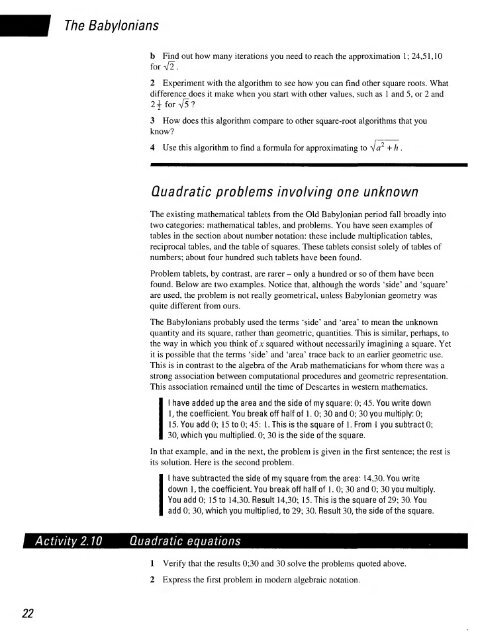history of mathematics - National STEM Centre
history of mathematics - National STEM Centre
history of mathematics - National STEM Centre
Create successful ePaper yourself
Turn your PDF publications into a flip-book with our unique Google optimized e-Paper software.
22<br />
The Babylonians<br />
Activity 2.10 Quadratic equations<br />
b Find out how many iterations you need to reach the approximation 1; 24,51,10<br />
for V2.<br />
2 Experiment with the algorithm to see how you can find other square roots. What<br />
difference does it make when you start with other values, such as 1 and 5, or 2 and<br />
2\ for V5?<br />
3 How does this algorithm compare to other square-root algorithms that you<br />
know?<br />
7<br />
4 Use this algorithm to find a formula for approximating to A/a 2 + h .<br />
Quadratic problems involving one unknown<br />
The existing mathematical tablets from the Old Babylonian period fall broadly into<br />
two categories: mathematical tables, and problems. You have seen examples <strong>of</strong><br />
tables in the section about number notation: these include multiplication tables,<br />
reciprocal tables, and the table <strong>of</strong> squares. These tablets consist solely <strong>of</strong> tables <strong>of</strong><br />
numbers; about four hundred such tablets have been found.<br />
Problem tablets, by contrast, are rarer - only a hundred or so <strong>of</strong> them have been<br />
found. Below are two examples. Notice that, although the words 'side' and 'square'<br />
are used, the problem is not really geometrical, unless Babylonian geometry was<br />
quite different from ours.<br />
The Babylonians probably used the terms 'side' and 'area' to mean the unknown<br />
quantity and its square, rather than geometric, quantities. This is similar, perhaps, to<br />
the way in which you think <strong>of</strong> x squared without necessarily imagining a square. Yet<br />
it is possible that the terms 'side' and 'area' trace back to an earlier geometric use.<br />
This is in contrast to the algebra <strong>of</strong> the Arab mathematicians for whom there was a<br />
strong association between computational procedures and geometric representation.<br />
This association remained until the time <strong>of</strong> Descartes in western <strong>mathematics</strong>.<br />
I have added up the area and the side <strong>of</strong> my square: 0; 45. You write down<br />
1, the coefficient. You break <strong>of</strong>f half <strong>of</strong> 1. 0; 30 and 0; 30 you multiply: 0;<br />
15. You add 0; 15 to 0; 45: l.This is the square <strong>of</strong> 1. From 1 you subtract 0;<br />
30, which you multiplied. 0; 30 is the side <strong>of</strong> the square.<br />
In that example, and in the next, the problem is given in the first sentence; the rest is<br />
its solution. Here is the second problem.<br />
I have subtracted the side <strong>of</strong> my square from the area: 14,30. You write<br />
down l,the coefficient. You break <strong>of</strong>f half <strong>of</strong> 1. 0; 30 and 0; 30 you multiply.<br />
You add 0; 15 to 14,30. Result 14,30; 15. This is the square <strong>of</strong> 29; 30. You<br />
add 0; 30, which you multiplied, to 29; 30. Result 30, the side <strong>of</strong> the square.<br />
1 Verify that the results 0;30 and 30 solve the problems quoted above.<br />
2 Express the first problem in modern algebraic notation.
















